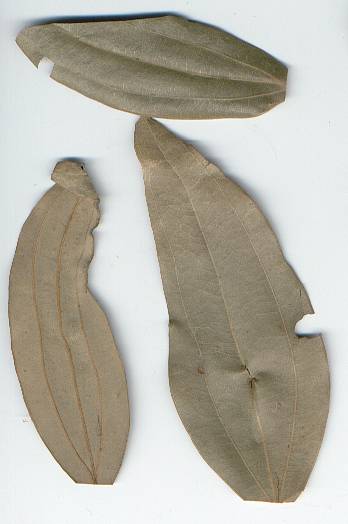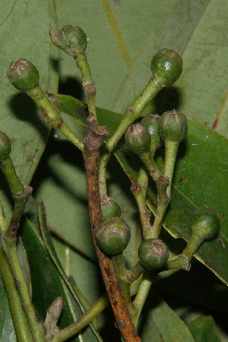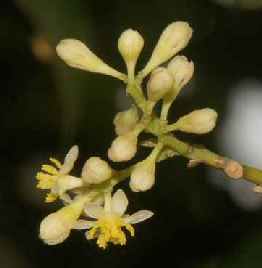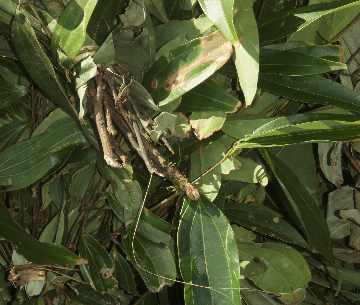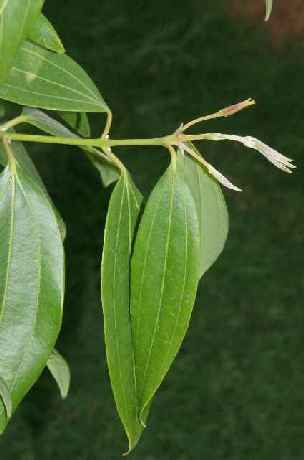
|
|
Twig of Indian Bay
|
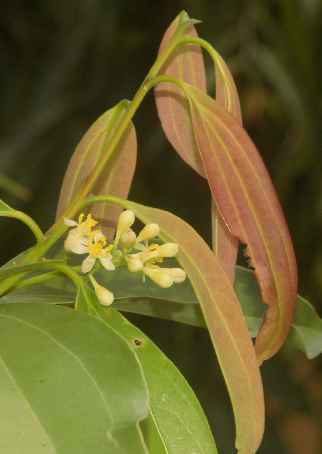
|
|
Flowers of Indian bay leaf
|
The Indian bay-leaves are the foliage of a tree closely
related to
cinnamon.
The tough, three-veined leaves are very popular in Northern India,
but are little known elsewhere — at least, today. They were well
known to the Romans under the name
malobathrum (also spelt
malabathrum) and used both for perfumery and in cooking; in
recipes, they were often just referred to as
folia leaves
,
which some cookbook editions misrender as
bay leaves.
See also
silphion for the flavours of ancient Rome.
Indian bay leaves might still have been available during the early Middle Ages; some medieval recipes for beer
brewing mention folia, but the identification is really unclear (see gale).
In any case, at some point of time between late antiquite and High Middle Ages, they fell victim to the multitude of
new spices then available, and were forgotten. They were rediscovered only in the Age of Exploration,
when Western scholars for the first time arrived in India and studied its products. In the 16.th century, Garcia de Orta encountered the leaves while travelling in India
and identified them with the spice known only from ancient records.

|
|
Flowers of Indian bay leaf
|
Today, Indian bay-leaves are a spice used almost exclusively in the
kitchens of Northern India, especially in the famous Moghul
cuisine that was developed at the Imperial courts in Delhi and Agra.
In accordance with the origins of the Moghul dynasty, Moghul cooking
contains elements derived from Arabic and Persian cooking.
This culinary style aims at a complexity and perfection comparable
to the architectonic beauty of the Taj Mahal, which was built
in the same era.
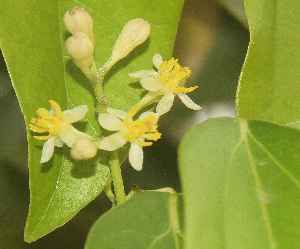
| |
Flowers of Indian Bay leaf
|
|
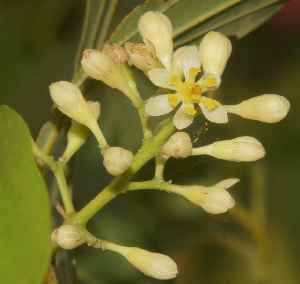
| |
Flowering twig of Indian Bay leaf
|
|
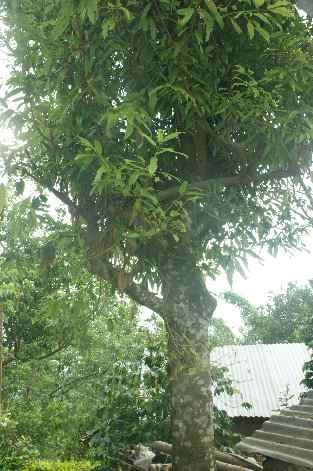
|
|
Tree of Indian bay-leaf
|
In Moghul cooking style, much use is made of sweet and aromatic spices; besides
Indian bay leaves, cinnamon, cloves and cardamom are
considered the most important spices for delicious rice dishes
(biryani [बिरयानी]).
Furthermore, Moghul cuisine is characterized by
rather small chile usage (contrasting habits in the
rest of India); cumin, which is a most popular
spice all over India, is frequently substituted by a closely related, but
culinarily different, plant known as black cumin
(see there for a fuller account on moghul cuisine).

|
|
Flowers of Indian Bay leaf
|
Indian bay leaves are found not only in biryanis, but also
in Moghul kormas, for which today the Northern Indian city
of Lucknow is famous. To make korma, meat (or occasionally
vegetable) is slowly but
for long time braised in a rich, fragrant sauce thickened with ground
almonds; often, the cooking pots are sealed
to avoid any loss of aroma. Indian bay-leaves also
form part of the Northern Indian spice mixture
garam masala (see cumin), which
is almost the only time when they are used in ground form.

|
|
Flowering twig of Indian Bay leaf
|
In the everyday cooking of Northern India, Indian bay-leaves are one of the most common spices,
and even more widely used than most other aromatic spices. They appear in almost every slow-cooked
food of the North and are particularly loved in Muslim-style meat curries. In South India, they are
much less known; sometimes, they get replaced by similar leaves like cinnamon
or allspice, but this is not standard.

|
|
Tree of Indian bay-leaf
|
Indian bay-leaves are very popular in the Terai plains of Southern Nepal.
Cooking in the Tarai is basically a mild version of North Indian cuisine,
and Indian bayleaves are a key flavour to the many vegetarian curries
of that area, particularly the Mithila region around Janakpur. I found the
highest concentration of them in potato curries. The Indian Bay-leaves are
also known and used in the mountains of North-Eastern India, bordering Burma.
There, they are often sold fresh.
Since Indian bay leaves were hardly available in the West bevor the turn of the millennium,
most older books encourage the use of laurel (the Mediterranean bay leaf)
instead. Though looking similar, the taste is very different, and
also weaker. The best substitutes are cinnamon
leaves or fresh cardamom leaves, but these are also
not easy to come by. I prefer the South American boldo
leaves: although their flavour is rather different, it is at least strong
enough for the highly spiced Moghul foods. Easier and still satisfactory
substitutes are a small piece of cinnamon bark or
a dried allspice berry.





